
|
|||||||
NATURAL ENVIRONMENT |
|||||||
Hong Kong’s topography and subtropical climate provide a wide range of habitats that support a rich variety of flora and fauna. Scenically, it has a great deal to offer – a landscape rising from sandy beaches and rocky foreshores to a height of almost 1 000 metres, with woodlands and hilly areas covered by open grassland, as well as a variety of scenic vistas rarely seen in such a small locale. In Hong Kong, there are more than 3 100 species of vascular plants, of which about 2 100 are native; some 50 species of mammals; 480 species of birds; 160 species of freshwater fish; 80 species of reptiles and more than 20 amphibian species. Insect diversity is also very high with more than 230 species of butterflies and 110 types of dragonflies. |
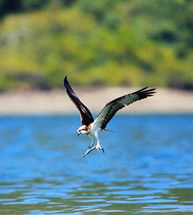 |
||||||
| ENHANCED NATURE CONSERVATION | |||||||
Under the New Nature Conservation Policy announced in November 2004, 12 priority sites have been identified for enhanced conservation through public-private partnership (PPP) and management agreements with landowners (MA). The Department is responsible for monitoring PPP and MA projects selected for implementation by the private sector or non-governmental organisation in these sites. As of March 2007, three pilot MA projects had been on-going for more than a year. Preliminary results indicated that the pilot projects had been effective in conserving and enhancing the biodiversity of the sites. The awareness of both the general public and local villagers of nature conservation had been raised and more information on and experience of effective management practices for the conservation of birds and butterflies had been obtained. |
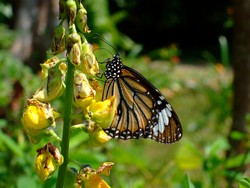 |
||||||
| ECOLOGICAL SURVEYS AND DATABASE | |||||||
| The Department has been conducting a territory-wide ecological survey programme since 2002 with a view to establishing and updating an ecological database for the whole of Hong Kong. The survey programme covers all major habitats of high conservation value in Hong Kong, including the location, status and composition of fung shui woods, as well as the distribution and abundance of selected animal groups. As of March 2007, more than 60 000 records of some 1 500 species of plants and animals had been collected, verified, and stored in the database. | |||||||
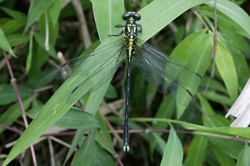 |
The survey findings confirm that Hong Kong has a rich biodiversity, including species new to Hong Kong and even new to science. In 2006-07, Camellia furfuracea and Clithon corona, new to Hong Kong, were confirmed. A dragonfly, Fukienogomphus choifongae, only described in scientific literature in March 2007, marked a species new to science. The findings further support that our protected areas encompass a very significant portion of this biodiversity. For the species groups surveyed and analysed, more than 95% of the terrestrial and freshwater representatives that are regularly seen in Hong Kong have representative population(s) inside our protected areas. |
||||||
| During the year, the Department continued to boost public interest in local biodiversity and win public support for nature conservation through its online database on representative species and habitats at Hong Kong Biodiversity Online (www.hkbiodiversity.net). The Department also developed a central database using the Geographical Information System, which incorporates survey data and ecological information available from other sources. | |||||||
THE MAI PO INNER DEEP BAY RAMSAR SITE |
|||||||
Since August 2001, the Department has implemented the Mai Po Inner Deep Bay Ramsar Site Ecological Monitoring Programme. This long-term monitoring programme aims to collect ecological baseline information on the marine benthic communities, over-wintering waterbird counts and the extent of habitation at the Ramsar Site. From October 2006 to March 2007, the highest winter count of waterbirds at the Ramsar Site was about 80 110, including some 33 780 ducks and grebes, some 19 050 shorebirds, some 12 000 gulls and terns, some 10 080 cormorants, some 4 400 egrets and herons, and some 800 rails and coots. In comparison with the winter figure for 2005, there was a 35% increase in the population of waterbirds in the Ramsar Site and it was the highest record since winter of 1992-93. |
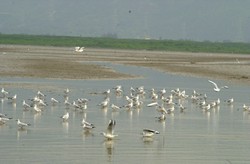 |
||||||
BLACK-FACED SPOONBILLS |
|||||||
The Black-faced Spoonbill is a globally endangered species that can only be found in the East Asia region. In 2006-07, about 28% of the global population made the Mai Po Inner Deep Bay Ramsar Site their winter or stop-over migration site. The Ramsar Site has the second largest number of wintering Black-faced Spoonbills in the East Asia region. Accordingly, maintaining the Ramsar Site in a favourable condition for the wintering Black-faced Spoonbills in Hong Kong has been an important aspect of the territory’s conservation plan since 2001. Other parts of the plan include safeguarding the site; species and habitat management; monitoring and research; education and training; as well as regional cooperation. |
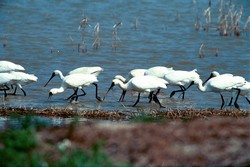 |
||||||
| GREEN TURTLES | |||||||
| Green Turtle is the only species of sea turtles that breeds regularly in Hong Kong. The Department has implemented the Green Turtle Conservation Programme to protect this endangered species. The programme includes restricting access to the Sham Wan Beach Restricted Area in Lamma Island during the nesting period from June to October each year to minimise activities that may otherwise take place to cause disturbances to the nesting of green sea turtles. Also, arrangement is made for clearing of climbers and marine garbage that may obstruct Green Turtles from nesting as well as for regular patrols and public education activities that focus on sea turtle conservation. | 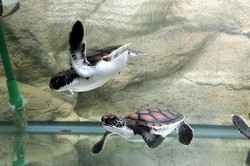 |
||||||
During 2006-07, there were no records of Green Turtle nesting at Sham Wan. Nevertheless, green turtle nesting on Tai Long Wan beach at the Sai Kung East Country Park was reported in late September 2006. After a period of 50 to 60 days, 56 juveniles were hatched by artificial incubation and 12 juveniles emerged under the natural process. The juvenile green turtles were reared jointly by the Department and the Hong Kong Ocean Park and were later released to the sea when the weather and water currents were suitable in the summer of 2007. According to the records, sea turtles had not nested on Tai Long Wan beach for more than thirty years. The Department would monitor the area to see whether green turtles would come back to nest again. |
|||||||
| CONTROL OF TRADE IN ENDANGERED SPECIES | |||||||
The Protection of Endangered Species of Animals and Plants Ordinance, which replaced the Animals and Plants (Protection of Endangered Species) Ordinance, came into operation in December 2006. The new Ordinance brings Hong Kong’s control regime to full compliance with the Convention on International Trade in Endangered Species of Wild Fauna and Flora (CITES). |
|||||||
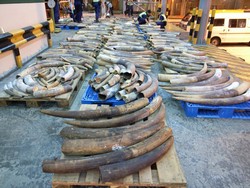 |
Efforts in combating illegal trade in endangered species continued. During the report period, over 360 seizures were made, including a shipment of 605 pieces (3 903 kg) of ivory tusks from Cameroon and 193 boxes (3 860 kg) of frozen crocodile meat from Thailand. A workshop on trade in Humphead Wrasse was held in Hong Kong in June 2006. In November 2006, the Department also co-organised a CITES regional enforcement seminar to develop capacity and liaison among the enforcement officials in the Southeast Asian region. |
||||||
Publicity and education work on endangered species protection was stepped up to promote public awareness of the need to conserve the species. These activities included organising visits to the Department’s Endangered Species Resource Centre, conducting talks in schools as well as arranging displays at the airport and border control points. Under a joint education programme between Hong Kong and Guangdong Province, a traders’ seminar and a training course for the CITES enforcement officials were organised. To apprise traders and the general public of the new Ordinance, a series of publicity work was also conducted, including circular letters to traders, public briefings, announcement on Department website, advertisements on public transportation, roving exhibitions at public venues, new posters, and broadcasts on radio and TV. An advisory leaflet on the new Ordinance was also distributed to the general public with water bills. |
|||||||
| THE HONG KONG WETLAND PARK | |||||||
The Hong Kong Wetland Park was opened in May 2006. It is a landmark in wetland conservation, with a mission to promote eco-tourism in Hong Kong and foster public awareness of the values of wetlands. The design of the Park has won much praise. During the year, the Park gained recognition in the Green Building Award organised by the Professional Green Building Council. The Park combines the natural beauty of 60 hectares of re-created wetland with a visitor centre of over 10,000 square meters showcasing sophisticated exhibits on wetlands. During the year, the Park attracted more than 1.1 million visitors. The Department is responsible for the management of the Park, with respect to daily operation, education and promotion, exhibit maintenance and habitat management. |
|||||||
In 2006-07, the Park conducted 2 678 guided visits for 81 795 students and visitors in the past year. A teaching kit was produced to help teachers in conducting the wetland education programme at the Park. In addition, a total of 24 public seminars attended by 2 210 visitors were held at the Park. The Park recruited over 2 000 volunteers under the Wetland Park Volunteers Scheme. These volunteers assisted in the operation of the visitor centre at the Park and offered guided tours for visitors. They also participated in outdoor habitat management work. Until March 2007, the cumulative number of man-days served by the volunteers was 2 531. |
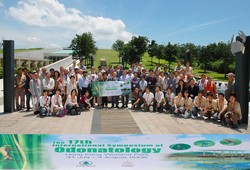 |
||||||
The Park plays an important role in promoting wetland conservation and education in the Asia Pacific region. The first WLI-Asia Symposium was held in the Park in late January 2007. The Symposium was officiated by Dr Peter Bridgewater, Secretary General of the Wetland Convention and attended by over 90 representatives from 19 countries and regions. It laid the foundation for continuous cooperation among the Asian wetland centres. Since 2003, the Department has been conducting habitat management at the site with a view to enhancing its ecological functions. The species richness of birds recorded has since increased, and the cumulative number of bird species recorded has exceeded 200. Waterbirds or birds dependent on wetlands which make up approximately 44% of all species have been recorded. The freshwater marshes were becoming more attractive to ducks in the winter of 2006-07. In addition to birds, ecological surveys conducted at the Park have recorded a variety of other species especially the wetland indicators – dragonflies, amphibians and reptiles. This shows that, with proper site design and management, the objectives of nature conservation, education and tourism can co-exist. |
|||||||
| HONG KONG HERBARIUM AND FLORA CONSERVATION | |||||||
| The Department manages the Hong Kong Herbarium which is responsible for the systematic collection, identification and maintenance of plant specimens of Hong Kong’s flora. During the year, the specimen collection of the Herbarium reached 40 000, more than 280 of which are type specimens that render the Herbarium regionally important. | |||||||
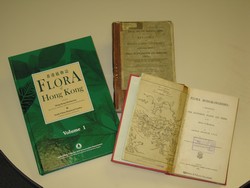 |
Some plant species were newly recorded during the year. The discovery of the fifth seagrass species, Small Halophila (Halophia minor), was published together with a taxonomic revision of the genus in botanical literature. A new record of Camellia, Chaff Camellia (C. furfuracea), was also discovered recently during the Department’s Biodiversity Survey and has been successfully propagated by the Field Investigation Unit. The Hong Kong Herbarium together with the South China Botanical Garden complied the Flora of Hong Kong. It is a definitive technical reference aimed at recording all known plant species in Hong Kong, and is the first flora book about plants of South China written in English and fully illustrated with colour photographs and botanical drawings. Volume 1 of the Flora was published in early 2007. | ||||||
| In addition to being a resource centre for plant workers, the Herbarium aims to enhance public awareness of local flora through organising guided visits and publishing educational materials. | |||||||
SITES OF SPECIAL SCIENTIFIC INTEREST |
|||||||
|
Sites of Special Scientific Interest (SSSI) may be land-based or aquatic sites, which are of special scientific interest because of their flora, fauna, geographical or geological features. During the year, the Department continued to patrol and monitor the conditions and scientific values of all SSSIs. Where warranted, the Department also carried out appropriate habitat management work at some SSSIs to maintain or enhance their scientific value. For instance, Mikania control was conducted at A Chau SSSI to improve the conditions of the trees at the site for egrets and herons to nest. The Department also continued to review the status of SSSIs and identify new sites suitable for SSSI listing or make proposals for de-listing those sites no longer deserving the SSSI status due to changes in circumstances over time after their listing. In 2006-07, one SSSI, Pak Sha Wan Peninsula, was de-listed from the SSSI Register. |
|||||||
| CONTROL OF MIKANIA | |||||||
Mikania (Mikania micrantha) is an exotic climber which grows rapidly in open and disturbed areas, such as roadsides and derelict land. The overgrowth of Mikania causes damage to other plants by cutting out light and smothering them. Since Mikania seldom grows in the shade, it does not result in any adverse impact on established woodlands with large trees and a close canopy. To prevent the proliferation of Mikania in any sites with conservation value, the Department continued to clear the plant when it was found in country parks, special areas and SSSIs. Besides mechanical weeding and a field trial on the application of sulfometuron-methyl herbicide, habitat management was applied on a trial basis. In addition, the Department has prepared the Nature Conservation Practice Note “Clearing Mikania”, which provides technical guidance to relevant government departments and landscape contractors responsible for the clearance of Mikania. The Department has also set up a website on Mikania for the public who are interested to know more about Mikania. The URL is: |
|||||||
CONTROL OF WILD MONKEYS |
|||||||
The wild monkey population in Hong Kong has been increasing in recent years and has caused public concern. To control the population increase in the long term, the Department has been conducting a pilot field trial of contraceptive treatment. In 2006-07, the Department carried out such treatment on 32 monkeys. |
|||||||